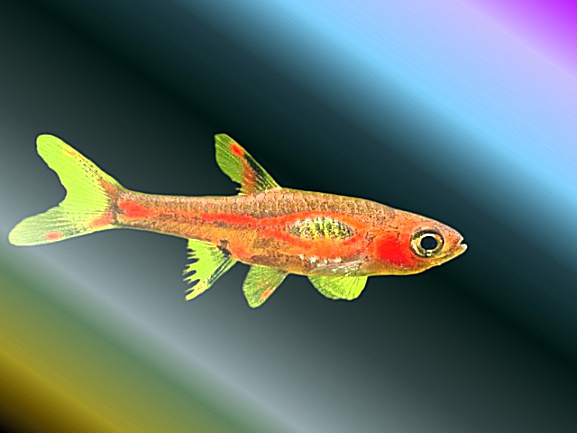When searching for one of the smallest nano fish suitable for a 5-gallon tank, chili rasboras are always recommended.
They often appear pale in fish stores, but after bringing them home and providing excellent nutrition for 3 to 6 months, their colors begin to emerge.
I have had my chili rasboras for 9 months, and I will now discuss their care requirements to determine if they are a worthwhile addition to an aquarium.
What is the Best Way to Quarantine Chili Rasboras?
My 5-gallon office tank needed inhabitants, so when I saw some chili rasboras at my local fish store, I purchased a group of 12 for 3 dollars each.
Normally, all new fish go directly into my quarantine container where I treat them with a medication trio of antibiotics, anti-fungal, and anti-parasitic treatments.
On one occasion, however, I attempted a more conservative approach by administering one medication per week to see what would happen.
Within the first week, 3 chili rasboras died. I immediately added the remaining two medications, and I did not lose any more fish.
I am not sure if the initial losses were a coincidence, but I will not be repeating that method.
What Do Chili Rasboras Look Like When They Settle In?
I first noticed that even in quarantine, my chili rasboras were not very shy after only a few days.
While they did not approach the glass to greet me, they were certainly not hiding and began to show a bit of color. After quarantine, I moved them into the 5-gallon tank, where they immediately became pale again.
I observed some glass surfing, an activity where they chase their own reflections, which made me believe they mistook their reflections for other chili rasboras.
It is clear that they require an adjustment period each time they are moved.
After about 2.5 weeks, they finally settled in, and I saw my first fully colored-up chili rasbora. The mature males develop a strikingly deep red.
The color is a cool-toned red with black markings, unlike the red-orange shade common to many other fish in the aquarium hobby.
Why Don’t Chili Rasboras Stand Out in an Aquarium?
I have noticed that my chili rasboras do not stand out prominently in the aquarium, and I believe there are a few reasons for this.
First, my aquarium has low lighting, which is further dimmed by floating water sprite I added to control algae. Unfortunately, the plant ended up shading everything, including the fish.
Second, they are incredibly small, measuring about 0.75 inches and possessing very slender bodies, making them inherently difficult to spot.
Third, my group does not school tightly because there is no larger fish in the aquarium to act as a predator and encourage that behavior.
In general, I might see an occasional red dot, but they are quite easy to miss.
What is the Best Tank Setup for Chili Rasboras?
The chili rasbora originates from the rainforests of Borneo in Indonesia.
Their natural habitat consists of waterways shaded by dense rainforest trees, where falling leaves release tannins that stain the water brown.
What are the Ideal Water Parameters?
These conditions create soft, acidic water with a pH of 7.0 or below.
However, I have found them to be quite hardy, as they are thriving in my own high pH water.
What Kind of Lighting and Plants Do They Need?
Because their native waters are darkened by foliage, low-light conditions help them feel more comfortable.
In my aquarium, I cultivate a dwarf aquarium lily, various cryptocorynes, narrow leaf java fern, and the previously mentioned floating water sprite.
What is the Best Filter for Chili Rasboras?
Since they are not strong swimmers, they require a very slow current.
I use a sponge filter in the aquarium, which is ideal as its gentle flow will not draw them in.
What is the Right Tank Size and Temperature?
They tolerate a standard temperature range of 72 to 82 degrees Fahrenheit.
For tank size, a minimum of 3 gallons is possible, though I currently keep 9 of them in a 5-gallon aquarium.
Their bioload is negligible, a fact aided by the numerous aquarium plants in my setup that consume nitrates.
What are Good Tank Mates for Chili Rasboras?
I have limited personal experience regarding tank mates, as I have not kept them with many other species.
My chili rasboras have coexisted peacefully with dwarf shrimp, mystery and nerite snails, a sparkling gourami, and a Mexican dwarf crayfish.
Any other extremely peaceful nano fish that is not a fast swimmer and can live in a 5-gallon aquarium would likely be a suitable companion.
What Do Chili Rasboras Eat?
I have found that feeding them requires some consideration.
While they are not picky, the food must be very small or soft enough for them to take bites from, such as Repashy gel food.
Mine are not particularly fond of Repashy because it sinks to the bottom, and they prefer foods that float or sink slowly in the mid-water column.
They are also not fast eaters, so I imagine they could be easily out-competed for food by other fish unless a widely dispersing food is used.
I enjoy feeding them frozen rotifers, easy fry and small fish food, and live micro worms.
My preferred foods are crushed krill flakes and baby brine shrimp, as these seem to enhance their red coloration.
How Do You Breed Chili Rasboras?
I have no experience breeding chili rasboras, likely because my pH is probably too high and the adult fish consume the eggs.
If I were to attempt breeding, I would use a mature tank with an acidic pH.
I would add catappa leaves and other botanicals to break down and create a thick layer of mulm, which cultivates biofilm and microfauna for the fry to eat.
For the fry to have a safe space, I would place a spawning mop or Java moss on the bottom and cover it with a layer of plastic craft mesh to prevent the adults from reaching the eggs.
I would condition the adult fish with live baby brine shrimp, which is an excellent conditioning food.
After they have spawned over a couple of days, the eggs should fall through the mesh. At that point, I would remove the adults and raise the fry.
The fry must be fed extremely small foods, such as infusoria and vinegar eels.
Eventually, after a couple of weeks, I could transition them to live baby brine shrimp.
Are Chili Rasboras Worth Keeping?
So, are they worth the effort? In my opinion, yes. I find them enjoyable because witnessing their deep red coloration develop over time has been personally rewarding.
I am not certain they are the best fish for beginners due to their somewhat neutral personality and the fact they are not easily visible in an aquarium, despite their vibrant color.
I would recommend them more for an intermediate fish keeper or a nano tank enthusiast.
I have considered rehoming them to try a different species, such as clown killifish or another pea puffer.
However, I have been hesitant to do so because they are so easygoing, hardy, and require little maintenance; I never have to worry about their aquarium.
In the meantime, I will continue to enjoy them. They are quite a cool species.
Conclusion
Chili rasboras, also known as Boraras brigittae, are tiny yet hardy nano fish that thrive in a 3 to 5-gallon aquarium filled with dense plant growth, low lighting, and gentle sponge filtration.
They prefer soft water with a slightly acidic to neutral pH, ideally at or below 7.0, and a temperature range between 72 and 82 degrees Fahrenheit.
I have found that they flourish in an environment enriched with tannin-rich botanicals, which mimics their natural habitat.
Their diet should consist of very small, slow-sinking or floating foods such as crushed krill flakes, live baby brine shrimp, frozen rotifers, and micro worms.
Although they tend to be shy and not the most visible fish in a setup, they peacefully coexist with dwarf shrimp, snails, and other calm nano fish.
Over time, especially after several months of steady, attentive care, the mature males develop a deep, vibrant red coloration that is genuinely rewarding to witness.
While they may not be the easiest fish for beginners, I consider them an excellent choice for intermediate fish keepers who enjoy maintaining a quiet, planted nano tank.

My name is Chibuzor Abraham Mba, and I’m the aquarist behind this website. I’ve spent years exploring the fascinating world of aquariums—especially small-scale tanks like nano and pico setups. Over time, I’ve made my fair share of mistakes, and through each one, I’ve learned valuable lessons.
